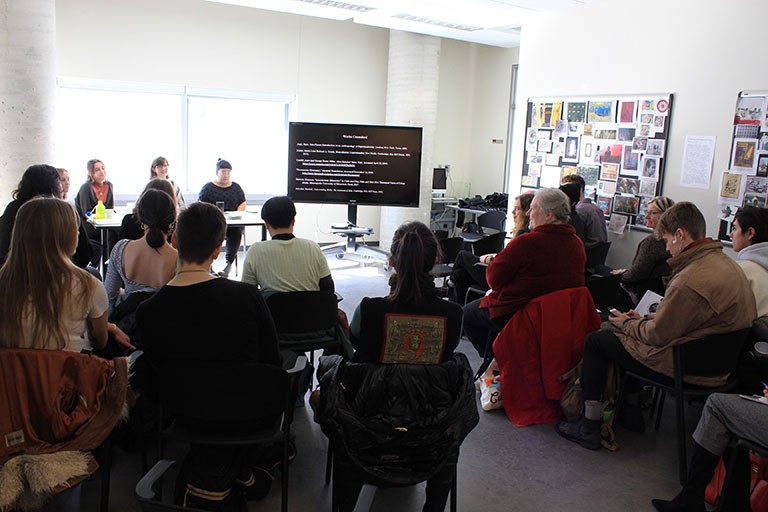On Feb. 16 and 17, Concordia’s Art History Undergraduate Journal (CUJAH) hosted their eighth annual conference, Dislocation: Art in a Mobile Age. The discussions focused on locality in art, drawing on issues of representation and mobility. The conference explored how artists claim spaces for production and exhibition. Guest speakers included Concordia students, artists, academics, workshop facilitators, and McGill Professor Charmaine A. Nelson, whose research focuses on black Canadian Studies in the Department of Art History.
In collaboration with CUJAH, The Fine Arts Students Alliance at Concordia (FASA) hosted a panel about redefining and creating spaces for artistic expression in the digital age. Guests discussed pushing the boundaries of a physical gallery space, and how they plan to move toward virtual mediums to present art.
The panel included speakers whose expertise extends beyond the confines of traditional institutions, including digital content creators and dance workshop facilitators. The FASA talk epitomized a new age in art and technology, bringing in creators who use a range of forms, including Google Maps, wearable computing, tech education, and sound and space research.
Lucas LaRochelle, founder of Queering the Map, discussed their storytelling platform and how it acts as a living archive of queer experience and collective memory. Queering the Map is a community-generated mapping project that geolocates queer moments and memories in physical, public spaces, offering queer people the opportunity to document their own experiences. LaRochelle’s mapping project, which started in early 2017, has over 15,000 documented moments in Canada, the U.S., and Australia, and is expanding globally. LaRochelle started the project to examine the relationship between space and memory.
“I was thinking about the multiplicity of feeling that is held in particular locations and what it means for me in relation to that place and what it would feel like to move in a world that was animated by the multiplicity of how people experience space,” LaRochelle said.
Florence Yee, a queer Toronto and Montreal-based artist, also spoke on the panel. Yee’s textile projects use text to reflect their experiences as a diasporic Cantonese person living in Montreal and the tensions that come with trying to express their culture and sexuality within the confines of white institutions. Drawing inspiration from their Cantonese-Canadian history, Yee examines the daily life of individuals in the diaspora through the lens of gender, race, and language. Yee noted the inclusion of their art in galleries as a reclamation of traditionally white, male-dominated spaces.
Nelson was the keynote speaker for CUJAH’s conference, where she presented her research on fugitive slave advertisements in the eighteenth and nineteenth centuries. Her talk focused on newspaper advertisements for slaves mainly in Nova Scotia, Quebec, and Jamaica and aimed to shed light on slavery in Canada.
“Found throughout the transatlantic world, fugitive slave advertisements demonstrate the ubiquity of African resistance to slavery,” Nelson writes. “Recalling fugitive slave advertisements as a form of visual culture, this presentation positions them as one part of the colonial infrastructure and network, including slave owners, printers, and jailers, that sustained the racialized distinction between free and unfree populations.”
CUJAH’s weekend-long conference reaffirmed why space matters when discussing the production and display of art. Although the artists, creators, and academics who attended came from diverse professional backgrounds, all of the speakers were keen to pave the way for the future of art.








